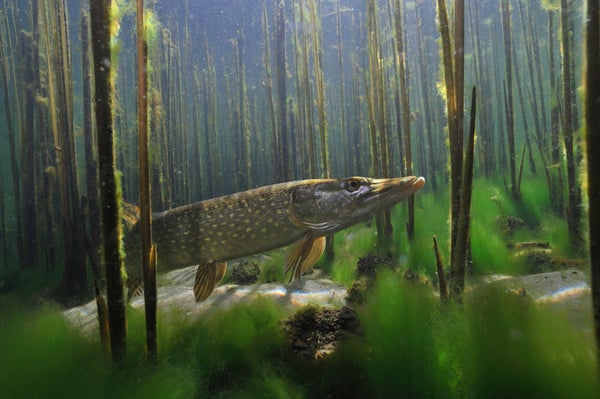Jon Sjoberg knew there was trouble this past July when recreational fishers approached him with two one-year-old, nine-inch northern pike. The fish came from Comins Lake, the fourth most popular fishery in Nevada. Until recently the lake had kept pike out, he says—“and then boom!” it was back.
In a seemingly unprecedented maneuver, the Nevada Department of Wildlife is offering $10,000 for information on the person responsible for releasing these predators in the lake. Officials hope to catch the criminal or criminals—and impress on residents how threatening invasive species can be.
Sport fishers all over the northern hemisphere love pike, but the Nevada Department of Wildlife’s stance is firm: no northern pike allowed. It is even illegal to possess a living specimen in the state, says Sjoberg, the department’s chief of fisheries. Whoever released pike into Comins Lake broke a law forbidding the introduction of the fish into Nevada waters. If found guilty the perpetrator could be fined between $25,000 and $250,000.
On supporting science journalism
If you're enjoying this article, consider supporting our award-winning journalism by subscribing. By purchasing a subscription you are helping to ensure the future of impactful stories about the discoveries and ideas shaping our world today.
Despite these financial penalties, “we think that the public doesn’t take our worries about this issue seriously,” says Edwin Lyngar, a spokesperson for the department’s law division. Ely, Nevada residents are the exception. The town nearest to Comins Lake benefits from the 30,000 to 40,000 anglers, or recreational fishers, who visit the fishery annually. The region is full of trout and large-mouth bass, which are also not native to the area, but are part of a thriving ecosystem. In the early 1980s and again in the 2000s, the pike invaded the lake, ate the other fish and then turned cannibalistic. With only one species left to catch, the anglers—and their money—disappeared. In the years needed to remove the second infestation, the fishery-based income dropped from around $2 million per year to about $73,000. Now the department fears these pike will topple the delicate eastern Nevada ecosystems again. “It is bad, and so bad that we have a $10,000 reward,” Lyngar says.
Josh Galperin, an environmental law professor at Yale Law School, says laws preventing invasive species introduction are common, but this is the first time he has heard of a bounty for the person responsible. None of the individuals Scientific American interviewed said they had seen this tactic used before.
Each state wildlife department has its own bag of tricks for eliminating unwanted animals. Many states like Nevada regulate boating equipment sanitization to prevent accidental transfers of species as boating gear hops from lake to lake. The Florida Fish and Wildlife Conservation Commission hosts hunts for invasives such as Burmese pythons and pays participants a reward for every snake they catch and bring in. And when a couple of pike showed up in the lake in 2015, Sjoberg and his team spent a quarter of a million—“that’s a lot of money for us,” he says—to poison all of Comins’ fish and the one other pike population found in nearby waters. That effort was so thorough that Sjoberg reasons these new inhabitants must have been intentionally released.
Christopher Chizinski trusts Sjoberg’s judgement. The department’s poisoning strategy follows the University of Nebraska ecologist’s recommendation for eliminating northern pike. Even though the wily species remembers and returns to the location where it was born, he says, a wide enough search could have eliminated all pike that call Lake Comins home. Chizinski does not know the ins and outs of Nevada waterways, but bets that those working in the region understand local fish migration well. “If they have a feeling somebody is putting [pike] in there, [intentional release] is a possibility,” he says. Galperin agrees. “You can get rid of them, but if people want them badly enough, they’ll get them,” he says.
To the organizations that funded the reward, pike dumping and subsequent culling of all fish in an ecosystem equates to poaching. “It’s taking a resource away from the sportsmen and women of the state,” says Chris Cefalu, president of Nevada Bighorns Unlimited, a nonprofit dedicated to preserving Nevada wildlife for sportspeople and nature enthusiasts. NBU and other ecosystem nonprofits have assisted big game poaching investigations in the past. Cefalu hopes this reward will increase awareness of illegal dumping and incentivize people to turn in dumpers.
With an anonymous hotline set up, Sjoberg and other department members will sit tight until that first tip arrives. They are even willing to run genetic testing on the captured pike to determine its source. And “in the future, someone considering doing this will see the reward, see the ruckus we made, and maybe think better of it,” Lyngar says.
